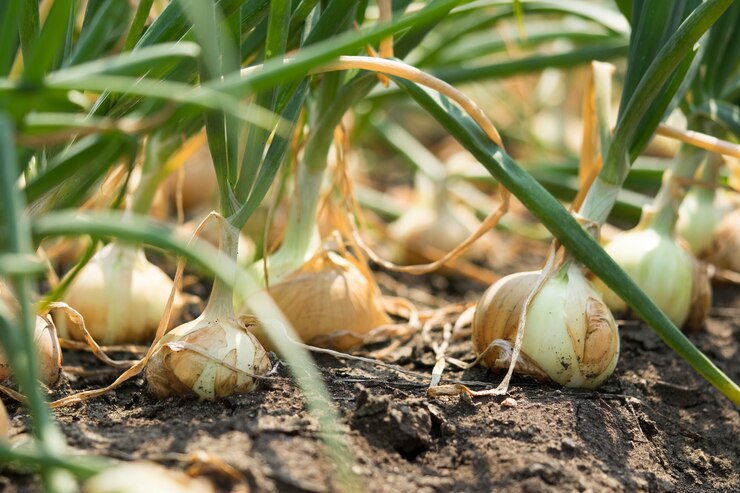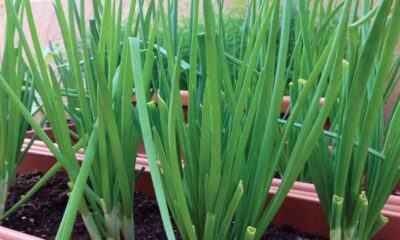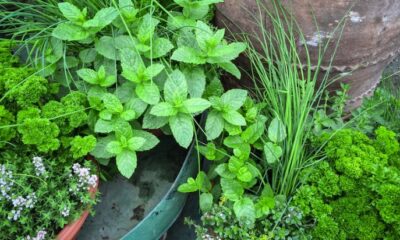Articles
How To Grow Garlic

Adapted from the Iowa State University Horticulture
How to Grow Garlic Using Sustainable Farming Practices:
Garlic (Allium sativum) is a member of the onion family (Alliaceae) along with onions, chives, shallots, leeks, and elephant garlic. Garlic is distinguished from other family members by its flat leaves and clove-like bulbs. Each garlic bulb contains several small scales or cloves enclosed in a white or purplish parchment-like sheath.
Cultivars
Garlic cultivars are classified as either hardneck or softneck.
Hardneck cultivars (Allium sativum var. ophioscorodon) produce a flower stalk (technically a scape) and are often termed “top-setting” or “bolting” cultivars. Flowers, if they are produced, usually abort. Bulbils (small bulblets) are produced on top of the scape. The flower stalks of some hardneck garlic are distinctly coiled. These types are referred to as rocambole or serpent garlic. Typically, hardneck garlic cultivars have 4 to 12 cloves surrounding the flower stalk. Because of the hard flower stalk, they are difficult to braid. Garlic Scapes are completely edible and considered a delicacy. Watch our recipes page for delicious ways to prepare garlic scapes.
Softneck cultivars (Allium sativum var. sativum) are sometimes referred to as “artichoke” cultivars and do not produce a seed stalk. These cultivars are commonly used in California for commercial production. However, some softneck cultivars are suitable for cold climates. Softneck cultivars are generally more productive than hardnecks because all the energy goes to producing a bulb rather than a bulb and flower stalk. Bulbs have 10 to 40 cloves arranged in layers. Softneck garlic tends to have a much longer shelf life than hardneck garlic and typically can be stored for 6 to 8 months without significant deterioration. They also are easy to braid.
Elephant, porcelain, or greathead garlic is actually a type of leek (Allium ampeloprasum). Elephant garlic is much larger than true garlic, often weighing as much as 1 pound per bulb. They also store well. The taste of elephant garlic is much milder than that of true garlic, but in cold climates it can develop a sharp or bitter taste.
Preparation of the Garlic Bulbs/Cloves
Open your garlic box the same day it is received! This will help prevent mold/mildew/rot, as it will allow the garlic to continue drying. Place the garlic in a cool location away from sunlight as you wait for the proper planting time.
Up to 2 days prior to planting (but not longer), “shuck” the garlic. Remove the outer husks and separate the cloves, leaving the skins on the individual cloves. Store the cloves in a cool location away from sunlight.
One helpful step to help avoid disease is to shuck your garlic away from your field/garden, so the dirt particles and shucks can not contaminate your soil. This may be an unnecessary precaution, but it’s an easy one to do. Therefore, we recommend shucking garlic away from your field/garden.
Dipping/soaking cloves: more to come here in the near future…
Planting
Planting Garlic: Garlic grows best in well-drained, fertile soils that are high in organic matter. Misshapen bulbs may result when garlic is grown in heavy, clay soils. Incorporating compost or well-rotted manure into heavy, clay soils can be beneficial. The optimum soil pH for garlic is between 6 and 7. Before planting, soils should be well tilled to provide a loose growing bed for bulb development. Because garlic plants do not produce true seeds, garlic is grown by planting cloves. Garlic cloves can be purchased at garden centers or from mail-order companies, though direct purchase online from growers is typically more economical.
Planting cloves from garlic purchased at the grocery store is not recommended because these are usually softneck cultivars that are mainly adapted to mild climates. Additionally, most grocery store garlic has been exposed to chemicals that postpone or prevent growth for longer shelf life.
Cloves should be planted in fall in most of the US (October to early November) or early spring (late March to early April). Spring-planted garlic will not likely achieve the same size as fall-planted garlic. Contact your local Extension Office or state Extension for information about planting times specific to your area.
Fall-planted garlic should be mulched with a 4- to 6-inch layer of weed-seed free straw to help prevent winter injury. In early spring, move the straw to between the rows to allow the garlic foliage to emerge and moisture to evaporate from the soil. The mulch helps control weeds during the growing season.
Late spring planting results in smaller bulbs at harvest.
Plant cloves with the pointed side up, root end down. When planted upside down, misshapen bulbs often develop. Plant cloves about 1 inch deep, or contact your Extension Office for recommended depth for your climate/zone.
Hardneck (top-setting) garlic cultivars also may also be grown from the bulbils or bulblets. Plant the bulblets in early spring and allow to grow in the same area for 18 months. By the end of the first season, the bulblets will form “rounds” or unsegmented bulbs. Left undisturbed, they will form a cluster of cloves by the following summer.
Spacing
Place cloves 3 to 5 inches apart within the row. Rows should be spaced 18 to 24 inches apart.
Fertilizing
We suggest that you contact your local agricultural extension office for recommendations specific to your growing area. A list of offices, by county, can be found here: http://www.clemson.edu/extension/county/https://www.clemson.edu/extension/ .
Garlic requires more fertilizer than many vegetables. Incorporate 1 to 2 pounds of an all-purpose garden fertilizer (10-10-10) per 100 square feet before planting. One month after planting apply an additional pound per 100 foot of row in a band 3 to 4 inches from the base of the plants. Avoid nitrogen applications after the first week of May because bulbing may be delayed. Soil tests should be taken before planting to determine phosphorus and potassium needs.
If you prefer to garden naturally, try fertilizing with blood meal, bone meal, and/or fish meal.
Maintenance
Water plants once per week during dry weather. Stop irrigating in late June to allow the foliage to yellow and die before harvest. Like an onion, garlic has a shallow root system. Weeds should be removed carefully to avoid disturbing or pulling up the garlic bulbs with the weeds. Mulches help control weeds and conserve soil moisture.
Potential Problems
Most garlic diseases are either soil- or set-borne and usually can be controlled with proper rotation and planting disease-free sets. Before planting, check each clove for signs of disease. Discard any infected cloves or bruised cloves because they may decay in the soil. Many garlic cultivars are susceptible to yellow tips.
The development of yellow tips early in the season (before bulbing) may drastically reduce yields. It is usually a sign of water stress, nutrient deficiency, or disease. Insects are not a major problem for garlic production, though a few destructive pests do exist.
Harvest and Storage
When is it best to harvest garlic? In late spring/early summer, the garlic begins to change from a green onion-looking plant to forming bulbs. The greatest part of the size develops in the last month before harvest.
Spring garlic looks similar to green onions. It has not yet begun to form cloves in mid/late April in Iowa. Spring garlic can be eaten, but of course won’t allow you to produce as large of a quantity as if it matures before harvest. Still, it is another unique way to enjoy your garlic!
Carefully dig garlic bulbs when the foliage starts to turn yellow and die, most often when half of the leaves are dying. Yellowing normally occurs between June and September (varying by climate/zone). Dry or cure the bulbs in a warm, well-ventilated, and shaded location for at least 2 to 3 weeks.
After drying, remove the foliage 1 inch above the bulbs or use the foliage to braid the bulbs together. Place the bulbs in a mesh bag or open crate and store where it is cool (32–40°F) and dry (65–70% relative humidity). Softneck types can be stored for 6 months or more, whereas hardneck types may only store for approximately 3-5 months. More about how to store garlic here.
For more information
If you have any questions, feel free to contact us!
Additional information also is available from these Web sites, and also your state’s Extension web site
All garlic seed for sale is supplied by our small micro farm in Elgin Oregon – Greifs Gourmet Garlic!
Articles
Why Buy Harley Davidson Full Face Helmets forYour Riding Style?

Many riders grapple with the decision of whether a full-face helmet is necessary, particularly when embarking on long journeys or high-speed adventures.
As you cruise down the open road or prepare for exhilarating high-speed rides, remember that your helmet is not just an accessory—it’s a vital piece of your riding gear.
Designed for riders like you who prioritize both safety and aesthetics, these Harley Davidson full-face helmets give you the confidence to ride in any condition, knowing you’re protected from whatever the road throws at you.
Why Your Riding Style Matters When Choosing a Helmet
For Cruisers
If you’re the type of rider who loves to take it slow and enjoy the scenery, you might think you don’t need a full-face helmet. But think again. Even at lower speeds, you’re exposed to elements like wind, dust, and road debris. A full-face helmet provides the best coverage for protecting your face and head, ensuring that your ride is as smooth and enjoyable as possible.
For Touring Riders
Long-distance riders need gear that can keep up with them. A full-face helmet does just that. Not only does it offer full protection from wind and weather, but it also reduces noise, making those long hours on the road more comfortable.
Plus, when you’re clocking in hundreds of miles, having a helmet that fits snugly and provides superior protection is a must. Harley Davidson full-face helmets are built with comfort in mind, featuring ventilation systems that keep you cool and padding that ensures a comfortable fit, no matter how long you ride.
For Performance Riders
If speed is your game, you know that safety is non-negotiable. For those who live for the thrill of high-speed riding or racing, a full-face helmet is essential. These helmets are designed to provide maximum protection at higher speeds, reducing wind drag while offering extra impact resistance. Whether you’re on the racetrack or pushing the limits on the highway, Harley Davidson helmets for sale ensure you stay protected without sacrificing style or comfort.
The Full-Face Advantage: Comfort Meets Protection
When considering whether a full-face helmet is necessary, ask yourself if you prioritize safety, comfort, and top-notch performance. Here are the compelling reasons to choose one:
Full Coverage for Full Protection
Unlike Harley Davidson half helmets, full-face helmets protect not just your head but your entire face. This means if you’re ever in an accident or even just riding through rough weather, your entire face is shielded from impact, wind, and debris. You’re also less likely to get hit by bugs or stones flying up from the road, making your ride more enjoyable.
Noise Reduction for Long Rides
One of the often-overlooked benefits of Harley Davidson full-face helmets for sale is noise reduction. Wind and engine noise can be distracting, especially on long rides. Full-face helmets help dampen that sound, giving you a quieter, more comfortable ride.
Weather Protection
Harley Davidson full-face helmets also offer superior protection against the elements. Whether it’s rain, sun, or even cold winds, your face stays protected.
If you’ve ever been caught in a downpour or had the sun glaring down on you during a ride, you know how uncomfortable it can get. A full-face helmet helps keep you comfortable, no matter what Mother Nature throws your way.
Style Matters: Why Harley Davidson Full Face Helmets are a Great Fit

Harley Davidson full-face helmets don’t just keep you safe; they look good doing it. With Harley helmets for sale in a variety of designs, you can choose one that matches both your bike and your personality. From sleek matte finishes to bold graphic designs, there’s something for every rider.
You’ll also find Harley Davidson helmets for sale online, making it easy to browse a wide selection and find the perfect helmet that fits your riding needs and your budget.
Where to Buy Your Harley Davidson Helmet
Now that you know why full-face helmets are a smart choice, the next step is finding the right one. Whether you’re shopping for full-face helmets or browsing Harley Davidson half helmets for sale, you have plenty of options. You can start by checking out online, where you’ll find a wide range of styles and sizes, all available for easy purchase.
If you prefer a more personalized experience, visit your local dealership. You’ll get expert advice and the chance to try on different models to ensure the perfect fit.
Invest in a Full Face Helmet for a Better Ride
Harley Davidson full-face helmets offer a combination of protection, comfort, and style that’s hard to beat.
Don’t wait—check out Harley Davidson helmets today, and buy Harley Davidson helmet options that fit your style, your needs, and your ride.
Articles
Linda Black Horoscope: A Guide to Your Astrological Journey

Astrology has captivated human imagination for centuries. Many people turn to their horoscopes to gain insight into their lives, personal relationships, career paths, and spiritual well-being. Among the many astrologers who have made their mark, Linda Black Horoscope stands out as a trusted source for accurate and insightful astrological readings. Linda Black’s daily horoscopes have helped millions navigate the cosmic energy and align themselves with the universe’s flow.
In this article, we’ll delve into the significance of Linda Black Horoscope, the different elements it covers, how to interpret your horoscope, and the impact astrology has on modern life. We’ll also include FAQs, an informative chart, and a concluding thought on how Linda Black’s horoscopes continue to shape people’s lives.
The Legacy of Linda Black Horoscope
Linda Black was an influential astrologer who provided daily horoscopes for millions of readers. Her passion for astrology and her innate ability to connect with celestial movements made her a celebrated figure in the field. Though she passed away in 2009, her legacy continues through her horoscope column, which is now curated and continued by trusted astrologers.
Linda Black’s horoscopes are known for their accuracy, clarity, and practical insights. Her readings offer guidance on everything from relationships and health to career decisions and financial opportunities. Unlike more generic horoscopes, Linda Black’s daily astrology reports are detailed and personalized, giving readers a sense of direction tailored to their zodiac sign.
What Makes Linda Black Horoscope Special?
There are many sources of astrology readings today, but Linda Black Horoscope stands out for several key reasons:
1. Precision and Accuracy
Linda Black’s horoscopes have always been noted for their precise insights. Whether it’s career advice, relationship guidance, or financial forecasts, her daily horoscopes have a reputation for being right on target. This is why so many people continue to rely on these readings to guide their decisions.
2. Holistic Approach
Linda Black’s horoscopes provide more than just vague predictions; they take a holistic approach to astrology. Her readings are comprehensive, combining planetary movements with real-world advice that touches every part of your life. From personal emotions to external factors, her horoscopes provide balanced perspectives that can help you make informed choices.
3. Easy to Understand
Astrology can be complex, especially when you start dealing with terms like retrogrades, aspects, and transits. Linda Black made sure her horoscopes were easy to understand, even for those with little to no knowledge of astrology. She explained how celestial events influenced different zodiac signs, translating complex astrological data into relatable insights.
4. Practical Guidance
Many horoscope readers are looking for practical guidance they can apply in their daily lives. Linda Black’s readings offer exactly that—clear advice on how to navigate challenges, take advantage of opportunities, and align with positive energy. Whether it’s a warning to avoid certain risks or a nudge to embrace new adventures, her horoscopes provide actionable advice.
The Key Components of a Linda Black Horoscope
Understanding how Linda Black Horoscope works can enhance your reading experience. Each horoscope reading typically consists of several components, helping readers get a well-rounded view of their day, week, or month.
1. Daily Horoscope
Linda Black’s daily horoscopes are the most popular. They provide bite-sized predictions tailored to each zodiac sign. These horoscopes focus on immediate aspects, such as career moves, relationship matters, or personal growth opportunities. The readings take into account the current planetary movements and how they specifically impact each sign.
2. Monthly Horoscope
For those looking to plan their month ahead, the monthly horoscope offers a broader overview. It highlights key dates, major astrological events like new moons and retrogrades, and how these can influence your goals. A monthly reading can offer insight into the bigger picture, helping readers plan long-term decisions.
3. Love Horoscope
Linda Black’s love horoscopes focus on matters of the heart. These readings dive deep into your romantic life, offering advice on how to approach relationships, navigate conflicts, and strengthen bonds. Whether single or in a relationship, love horoscopes can provide a roadmap for emotional harmony.
4. Career and Finance Horoscope
These readings provide tailored advice for professionals and entrepreneurs. The career and finance horoscope gives insight into opportunities for growth, challenges to be mindful of, and advice on how to manage financial affairs. Whether you’re looking for a promotion, considering a career switch, or evaluating an investment, this segment can offer valuable foresight.
5. Health and Wellness Horoscope
Many readers look to astrology for advice on physical, mental, and emotional well-being. Linda Black’s health horoscopes provide insights on how celestial energy impacts your vitality, stamina, and mental clarity. By aligning your health practices with favorable astrological periods, you can take better care of your overall well-being.
How to Read and Interpret Linda Black Horoscope
If you’re new to astrology or Linda Black Horoscope, understanding how to interpret these readings can enhance your experience. Here are some tips on how to get the most out of your horoscope:
1. Know Your Sun, Moon, and Rising Signs
While most horoscopes are written based on your sun sign (your primary zodiac sign), other factors, like your moon sign and rising sign, also play a significant role in shaping your personality and life experiences. For the most accurate insights, try to read horoscopes that account for all three.
2. Look for Key Themes
Daily horoscopes often revolve around central themes such as love, career, or personal growth. As you read, identify the main themes and think about how they apply to your current life situation. For instance, if your horoscope advises you to be cautious in your relationships, consider whether you’ve been experiencing any tension or unresolved issues with loved ones.
3. Use Horoscopes as Guidance, Not Predictions
It’s essential to remember that horoscopes are guidelines, not fixed predictions. They provide insight into potential outcomes based on planetary movements, but you have the free will to make your own decisions. Use your horoscope as a tool to help guide your choices and actions.
4. Be Open-Minded
Astrological advice may not always align with what you expect. It’s important to approach your horoscope with an open mind, embracing new perspectives and possibilities that may not be immediately obvious. Over time, you may begin to see patterns that resonate with your life experiences.
The Essential Components of a Linda Black Horoscope
| Horoscope Type | Focus Area |
| Daily Horoscope | Immediate, daily insights into personal, career, and relationship matters. |
| Monthly Horoscope | Overview of major astrological events and how they influence long-term goals. |
| Love Horoscope | Focuses on romance, relationships, and emotional well-being. |
| Career and Finance | Tailored guidance on professional decisions and financial matters. |
| Health and Wellness | Advice on physical, mental, and emotional health based on astrological factors. |
Conclusion
Linda Black Horoscope continues to be a trusted source for millions of astrology enthusiasts worldwide. From offering precise daily insights to providing comprehensive monthly overviews, Linda Black’s horoscopes help guide readers through life’s twists and turns. Whether you are seeking advice on love, career, or health, her readings offer practical wisdom grounded in the stars.
As astrology continues to grow in popularity, the legacy of Linda Black remains ever relevant. Her intuitive readings, easy-to-understand guidance, and the practicality of her advice make her horoscopes a valuable tool in navigating the complexities of life. If you’re looking to harness the power of the universe and align yourself with cosmic energies, the Linda Black Horoscope is an excellent place to start.
By incorporating Linda Black Horoscope into your daily routine, you’ll gain new perspectives, deeper self-awareness, and a sense of control over the paths you choose. The universe has a message for you—let Linda Black help you decode it.
FAQs
Who was Linda Black, and why are her horoscopes so popular?
Linda Black was a renowned astrologer who provided daily horoscopes to millions of readers. Her horoscopes gained popularity due to their accuracy, practical advice, and approachable style. Although she passed away in 2009, her horoscopes are still continued by other trusted astrologers, maintaining her legacy.
How can I access Linda Black Horoscope?
You can access Linda Black Horoscope through various websites and astrology platforms. Many newspapers and online publications also feature her daily horoscopes.
Are Linda Black’s horoscopes still accurate?
Yes, the astrological predictions made by Linda Black’s successors continue to uphold her high standard of accuracy. The horoscopes are based on real-time planetary movements and are updated daily to reflect current cosmic influences.
Can horoscopes predict my future?
Horoscopes offer guidance based on astrological patterns, but they are not definitive predictions. They are best used as tools for self-reflection and decision-making rather than as absolute forecasts.
Can I get a personalized horoscope from Linda Black?
While Linda Black is no longer with us, her successors continue to offer personalized horoscopes that take into account individual birth charts, allowing for more tailored advice.
Articles
The Value of “Kevin Sterdurnt PDF”: A Comprehensive Guide

In today’s digital era, the need for accessible information has led to the increasing use of PDFs (Portable Document Format). For enthusiasts and researchers searching for in-depth knowledge, one name has gained traction – Kevin Sterdurnt PDF. Whether you’re seeking educational material, expert insights, or niche content, this document format attributed to Kevin Sterdurnt provides readers with a valuable resource. This article will delve deep into the world of “Kevin Sterdurnt PDF,” exploring its relevance, uses, and the value it holds for users.
What is Kevin Sterdurnt PDF?
The “Kevin Sterdurnt PDF” refers to documents created, authored, or linked to a professional, expert, or educator named Kevin Sterdurnt. This name has been associated with a variety of resources available in PDF format, focusing on topics like finance, technology, personal development, and much more. These PDFs are often used by students, professionals, and researchers looking for high-quality information in a structured, easy-to-read format.
While the exact topics covered by these PDFs might vary, what remains consistent is their reputation for delivering well-researched, factual, and practical information. For many, the name Kevin Sterdurnt has become synonymous with credibility and depth in the knowledge being shared.
The Importance of PDFs in Knowledge Sharing
PDFs have revolutionized the way information is shared. This widely-used format allows users to view documents in the exact layout intended by the creator, whether on mobile devices, tablets, or computers. The portability and compatibility of PDFs make them an excellent medium for sharing complex information, from textbooks to research papers.
The “Kevin Sterdurnt PDF” offers several unique benefits:
- Ease of Distribution: PDFs can be shared across different platforms without worrying about formatting issues, ensuring that the document’s original design is preserved.
- Security: Many PDFs, including those authored by Kevin Sterdurnt, come with options for encryption or password protection, ensuring the content’s integrity.
- Accessibility: With built-in accessibility features, PDFs can be adapted for readers with disabilities, making them a valuable resource for a wider audience.
Key Topics Covered in Kevin Sterdurnt PDFs
Kevin Sterdurnt PDFs span across multiple domains, making them versatile and resourceful for a wide array of audiences. Let’s explore some key areas where these documents can prove beneficial:
1. Finance and Investment
Many Kevin Sterdurnt PDFs explore finance-related topics, offering readers insight into personal finance, investment strategies, stock markets, and wealth management. These PDFs are perfect for individuals looking to build a strong financial foundation or advance their investment knowledge.
For example, a PDF titled “Kevin Sterdurnt: Mastering Cryptocurrency” may cover:
- Understanding blockchain technology
- Tips for safe crypto investments
- Market trends and predictions
2. Technology and Innovation
Kevin Sterdurnt PDFs also address cutting-edge technological advancements. Whether it’s artificial intelligence (AI), blockchain, or advancements in Internet of Things (IoT), readers can expect to stay ahead of the curve with these detailed guides.
A popular PDF in this category might be titled “Kevin Sterdurnt: Navigating the Future of AI,” covering:
- AI’s potential in different industries
- Ethical concerns surrounding AI
- Implementing AI in businesses
3. Self-Development and Motivation
Another core theme in Kevin Sterdurnt PDFs is personal development. Self-growth enthusiasts benefit from the practical advice on setting goals, enhancing productivity, and overcoming challenges.
A self-development PDF might focus on topics like:
- Building effective daily routines
- Goal-setting techniques
- Mindfulness and mental well-being
4. Entrepreneurship and Business
For aspiring business owners or established entrepreneurs, Kevin Sterdurnt’s PDFs offer insights into starting, running, and scaling a business. From marketing strategies to navigating the world of e-commerce, the content is valuable for those aiming to build a successful enterprise.
A sample PDF might be titled “Kevin Sterdurnt: Strategies for Business Growth in 2024” and could include:
- Innovative marketing techniques
- Digital transformation for businesses
- Scaling strategies for small and medium-sized enterprises
5. Educational Resources
Students and educators can find immense value in Kevin Sterdurnt’s educational PDFs. Whether it’s learning material on complex subjects like quantum physics or guides on acing standardized tests, these PDFs are tailored to meet educational needs.
An educational PDF might feature:
- Explanations of complex mathematical problems
- Study strategies for competitive exams
- Research methodologies and techniques
The Value of “Kevin Sterdurnt PDF” Resources
Below is an informative chart that highlights the key benefits and applications of Kevin Sterdurnt PDFs in various fields:
| Field | Benefits of Kevin Sterdurnt PDFs | Target Audience |
| Finance | Detailed investment strategies, cryptocurrency insights, market analysis | Investors, Financial Analysts, Economists |
| Technology | In-depth discussions on AI, IoT, blockchain, and cybersecurity | Tech Enthusiasts, IT Professionals |
| Self-Development | Tips for productivity, mindfulness, goal-setting, and personal growth | Self-Help Enthusiasts, Coaches |
| Entrepreneurship | Business growth strategies, digital transformation, marketing tips | Entrepreneurs, Business Owners |
| Education | Comprehensive study guides, learning materials, research methodologies | Students, Educators, Academics |
How to Access Kevin Sterdurnt PDFs
Finding and downloading Kevin Sterdurnt PDFs is straightforward. Most of these resources are available through online libraries, educational platforms, or specialized websites that host quality PDFs. Some are freely available, while others may require a subscription or one-time purchase.
Popular websites where Kevin Sterdurnt PDFs may be available include:
- Academia.edu
- ResearchGate
- Personal Websites/Blogs of Kevin Sterdurnt or associated professionals
- Libraries offering digital document services
Conclusion
The “Kevin Sterdurnt PDF” has become a valuable tool for individuals seeking knowledge across a wide range of disciplines, from finance to self-development and technology. These PDFs offer well-organized, research-backed content, easily accessible to readers worldwide. Whether you’re a student, an entrepreneur, a self-help enthusiast, or a tech professional, there is something for everyone in the world of Kevin Sterdurnt PDFs.
The portability, accessibility, and trustworthiness of PDFs, combined with the knowledge and expertise shared by Kevin Sterdurnt, make these resources an invaluable part of the digital learning ecosystem. By exploring the vast library of Kevin Sterdurnt PDFs, you can enhance your knowledge and apply it to achieve your personal and professional goals.
Ultimately, with so much information available at your fingertips, taking advantage of resources like the Kevin Sterdurnt PDF can provide you with the competitive edge you need in today’s rapidly evolving world.
FAQs
What types of content can I expect from a Kevin Sterdurnt PDF?
Kevin Sterdurnt PDFs cover a broad spectrum of subjects, including finance, technology, self-development, education, and entrepreneurship. Readers can expect well-researched, factual, and practical information in each PDF.
Are Kevin Sterdurnt PDFs free to access?
Some Kevin Sterdurnt PDFs are freely available, especially on open-access platforms like Academia.edu or educational websites. However, certain specialized PDFs may require a subscription or one-time payment.
How do I ensure the authenticity of a Kevin Sterdurnt PDF?
To ensure you are accessing an authentic Kevin Sterdurnt PDF, download from reputable sources, and avoid third-party websites that may host counterfeit or altered versions.
What formats are Kevin Sterdurnt’s documents available in?
While PDFs are the most common format, you may also find some of Kevin Sterdurnt’s work in formats like ePUB or DOCX for added flexibility.
Can I share Kevin Sterdurnt PDFs with others?
Yes, most Kevin Sterdurnt PDFs can be shared, but make sure to respect the copyright and distribution terms attached to the document. Some PDFs may come with sharing restrictions, so always review the terms before distributing.
-

 Articles7 months ago
Articles7 months agoHow Many Times Can You Regrow Green Onions
-

 Entertainment5 months ago
Entertainment5 months agoBare it All: Unforgettable Skinny Dipping Stories Shared
-

 Fashion6 months ago
Fashion6 months agoMake a Statement with Stunning Black Homecoming Dresses
-

 Articles7 months ago
Articles7 months agoWHAT IS THE DIFFERENCE BETWEEN SEED GARLIC AND FOOD GARLIC?
-

 Technology5 months ago
Technology5 months agoNavigating TG Tube: Your Guide to Transgender Content Online
-

 Articles7 months ago
Articles7 months agoHOW TO CHOOSE YOUR FAVORITE GARLIC VARIETIES?
-

 Entertainment7 months ago
Entertainment7 months agoExploring the Fascinating World of The Kristen Archives: A Closer Look
-

 Articles7 months ago
Articles7 months agoWHAT IS THE BEST POTTING SOIL FOR HERBS?
